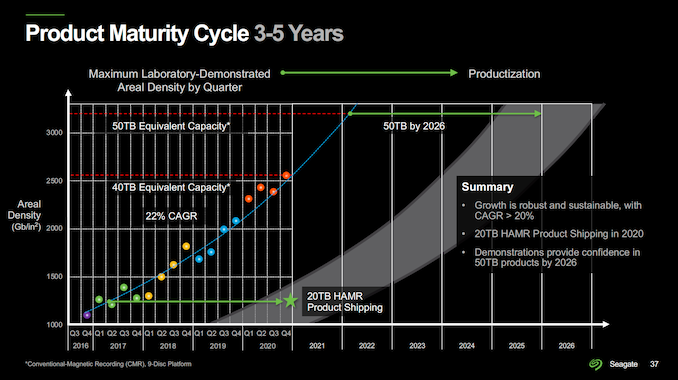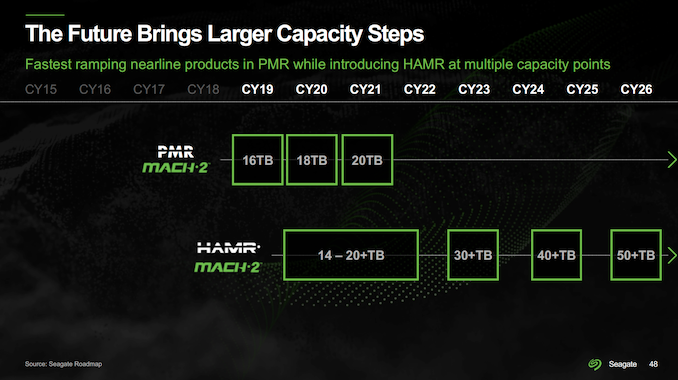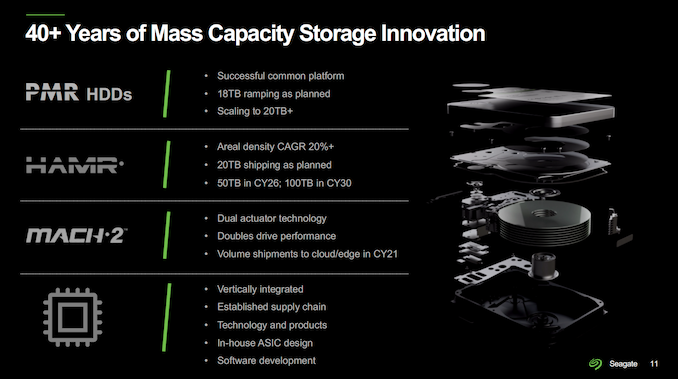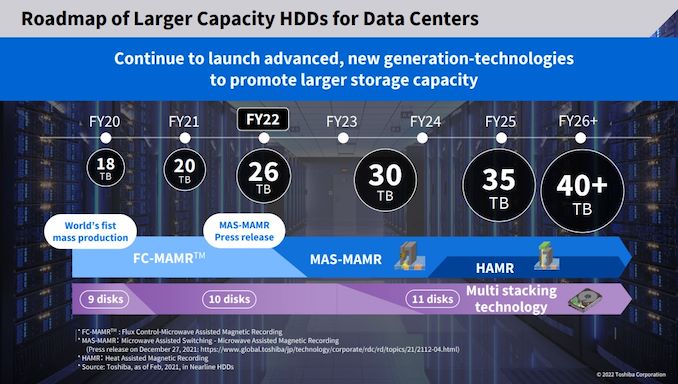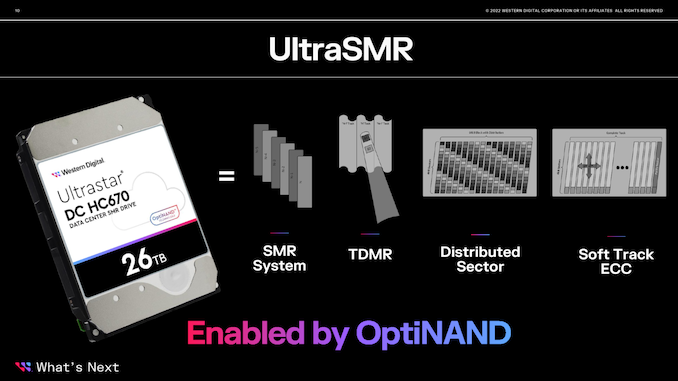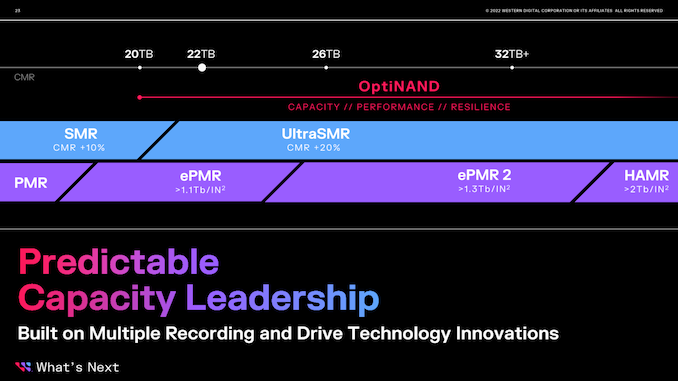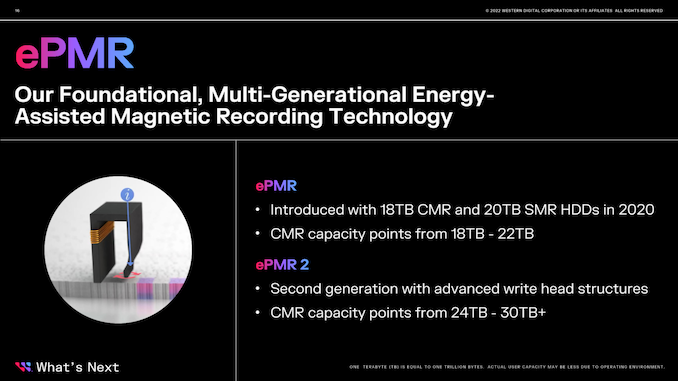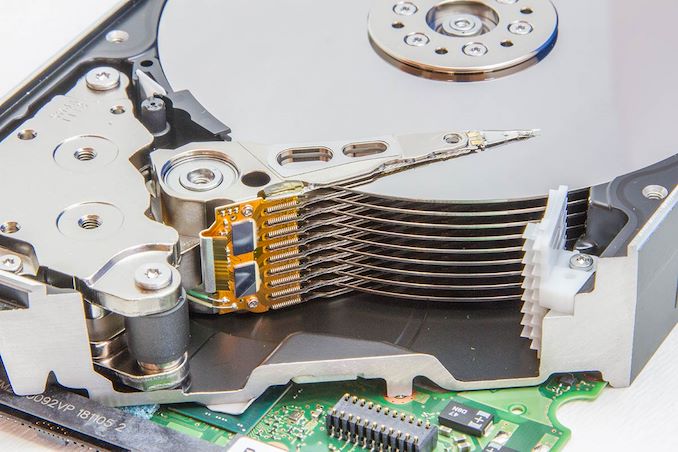- Like
- SHARE
- Digg
- Del
- Tumblr
- VKontakte
- Flattr
- Buffer
- Love This
- Save
- Odnoklassniki
- Meneame
- Blogger
- Amazon
- Yahoo Mail
- Gmail
- AOL
- Newsvine
- HackerNews
- Evernote
- MySpace
- Mail.ru
- Viadeo
- Line
- Comments
- Yummly
- SMS
- Viber
- Telegram
- JOIN
- Skype
- Facebook Messenger
- Kakao
- LiveJournal
- Yammer
- Edgar
- Fintel
- Mix
- Instapaper
- Copy Link
In the recent months all three hard drive manufacturers — Seagate, Toshiba, and Western Digital — and some of their partners have outlined plans to ship 30TB HDDs already in 2023 ~ 2024 timeframe. Apparently, all of these companies plan to use different technologies to get to this milestone.
Demand for high capacity nearline hard drives has been increasing for years and is not going to stop, as more data is generated each and every day. But nearline HDD users not only want their drives in large quantities, but they want a rapid increase in capacity as well, in a bid to keep the number of drives (and therefore the number of servers and power consumption of datacenters) in check. But capacity increases have been slowing down in the recent years, mainly because of slow roll out of energy-assisted magnetic recording (EAMR) technologies.
Seagate: Going Boldly with HAMR
Seagate has always envisioned that its heat-assisted magnetic recording (HAMR) technology would be the key enabler of radical areal density improvements after technologies like perpendicular magnetic recording (PMR), two-dimensional magnetic recording (TDMR), and shingled magnetic recording run out of steam.
Indeed, Showa Denko K. K. (SDK), the world’s largest independent hard drive platter manufacturer, believes that HAMR would achieve areal recording densities of 5-6 Tb/in2 in the future. This would enable 3.5-inch hard drives with eight or nine platters to store 70 TB – 80 TB of data. Seagate's rivals Toshiba and Western Digital agree that HAMR will be a technology of choice in the longer-term future, but for now and the next few years to come, energy-assisted PMR (ePMR) and microwave-assisted magnetic recoding (MAMR) technologies are expected to be just fine.
But HAMR is challenging. A HAMR-based drive requires an all-new right head with a laser to heat the media before recording data, in order to temporarily change its magnetic coercivity. As well, TDMR read heads are needed to mitigate possible magnetic inter-track interference (ITI) effects.
Meanwhile, HAMR requires all-new platters that can handle a 450°C or higher local heat (made using a laser with an ~810 nm wavelength and a ~20 mW power) all without deforming over time. These platters use glass substrates and high anisotropy thin film magnetic layer made of an Fe-Pt alloy and featuring a new structure to ensure reliability. By contrast, transition to various kinds of MAMR is a less radical one.
Seagate started to ship its 1st Generation HAMR-based HDDs in 2019 ~ 2020, when it released the drives to select customers and inside its Lyve storage systems. These drives offered capacities up to 20TB – class-leading at the time – but for some reason Seagate decided not to make these HAMR products available to a wider audience.
Instead, the company is shipping 20TB drives featuring conventional (non-shingled) magnetic recording (CMR) and 22TB SKUs featuring SMR. And over the next several months, 22TB HDDs enabled by a combination of many platters, head innovation, TDMR, and other novelties are also planned for this year.
Seagate is also developing its 2nd Generation HAMR hard drives, which will enable capacities of over 30TB. But the company is not disclosing when it expects these HDDs to become available. All we know for sure is that last year Seagate inked a deal with SDK to secure a second source of HAMR platters; so we would expect the company to finally make HAMR-based products more widely available sooner than later. In fact, Seagate's public roadmap indicates a 30 TB HDD in calendar 2023.
“Seagate's leadership in mass capacity technology and strong product portfolio makes us ideally positioned to capture these opportunities from the 20 TB+ drives we are shipping today to the 30 TB+ HAMR products under development,” said David Mosley, CEO of Seagate, back in April.
Toshiba: Betting on MAMR
Toshiba adopted flux-control microwave-assisted magnetic recording (FC-MAMR) technology in 2021 for its 18TB HDD and announced plans to use microwave assisted switching MAMR (MAS-MAMR) technology for its ~26TB drive due in fiscal 2022 (which ends on March 31, 2023). Eventually, the company intends to get to 30TB HDDs between FY2023 (April 1, 2023 — April 1, 2024) with a MAS-MAMR drive that uses 11 platters.
Specially for Toshiba, Showa Denko has developed special platters optimized for FC-MAMR and MAS-MAMR technologies, whereas TDK designed appropriate write heads for the company. All-in-all, Toshiba has everything it needs to keep its HDD evolving for the coming years.
In the longer-term future, sometimes in FY2024 (April 1, 2024 — April 1, 2025), Toshiba is looking at adopting HAMR, but for two or three years the company is going to stick to various kinds of MAMR – at least according to the roadmap that the company presented in February, 2022.
Western Digital: ePMR, EAMR, HAMR
Western Digital has perhaps the most convoluted HDD roadmaps of all three manufacturers. The company demonstrated advantages of MAMR back in 2017 and then promised that the first drives featuring the technology will be available in 2019. Transition to MAMR is considerably easier than transition to HAMR, as while it requires new write and read heads, it does not require entirely new media. But the areal density advantages that MAMR brings are considerably lower than compared to those of HAMR. Still, a relatively simple transition is among the main reasons why both Toshiba and Western Digital decided to adopt the technology.
But while developing MAMR, Western Digital discovered 'a variety of energy assisted techniques' to temporarily lower magnetic coercivity of the recording media without using a spin-torque oscillator, a crucial and relatively complex technology required for MAMR. The company collectively calls these techniques EAMR.
As a result, in September 2019 the company introduced its Ultrastar DC HC500-series 18TB HDDs, which used WD's previously-unannounced energy-assisted PMR (ePMR) technology. ePMR allows areal recording densities to be increased to over 1.1 Tb/inch2, which is also considered to be the maximum density attainable for regular PMR. For cold storage applications, the company introduced its Ultrastar DC HC600-series 20TB drives that combined energy-assisted recording with shingled recording, adding another ~10% to capacity.
To achieve a 20 TB capacity with nine CMR platters (Seagate's 20TB drive uses 10 platters), Western Digital had to introduce its OptiNAND technology. And then to get to 22TB with CMR, it added another platter to the package anyhow, likely requiring a major rework of internals as well as usage of new (thinner) platters. During its Investor Day, Western Digital emphasized that its 22TB and 26TB HDDs continue to use aluminum (AlMg) platters, though the company has declined to comment about the magnetic films used.
Meanwhile, in a bid to offer a rather exclusive 26TB HDD to its exascale customers, Western Digital is also adopting the so-called UltraSMR set of technologies, which promise to add around 20% more capacity to CMR platters (and in this case to the 22TB HDD). To make UltraSMR possible, Western Digital not only had to increase the number number of shingled bands and reduce the number of CMR bands (conventional, perpendicular-style magnetic recording bands), but employ all of its leading-edge HDD technologies. This includes triple stage actuators with two-dimensional (TDMR) read heads, ePMR write heads, OptiNAND technology, and a proprietary error correcting code (ECC) technology with large block encoding to ensure that increased adjacent tracks interference (ATI) does not harm data integrity. That sophisticated ECC capability, in turn, may very well prove crucial for both SMR and CMR hard drives over the coming years.
Western Digital's upcoming 22 TB CMR HDD continues to rely on ePMR technology, whereas its successors will use the so-called ePMR 2 technology, which allows for areal densities over 1.3 Tb/inch2 (or approximately 18% over ePMR). We do not have further technical details on ePMR 2 (beyond that it naturally falls into the EAMR category), but Western Digital says that it will eventually enable 30TB+ CMR HDDs.
With its ePMR 2 technology, Western Digital can theoretically increase the capacity of its current 2 TB platters by around 18%, bringing them to 2.36 TB. This would get WD to 24 ~ 25 TB per drive next year, depending on the actual areal density it can achieve and the number of platters it is willing to install. With UltraSMR on top, WD would be able to add another 20% capacity and formally launch a 30TB UltraSMR HDD potentially as soon as next year. At this point the only real question is when these drives are set to ship in volume, keeping in mind that Western Digital's customers will need to thoroughly qualify them.
How fast ePMR 2 will enable CMR drives to reach 30 TB, on the other hand, is something that will depend on the pace of ePMR 2's evolution. But we have every reason to believe that with ePMR 2 and UltraSMR Western Digital will be able to conquer the 30 TB milestone sometimes next year.
Showa Denko: 30 TB HDDs Due in 2023
Meanwhile, Showa Denko is also confident that 30 TB hard drives will be introduced next year. Back in May Showa Denko formally introduced its 2.60 TB platters, which will be used in 26 TB HDDs set to be released this year. And the company has said that its next-generation media will enable 30 TB+ nearline drives for next year.
“We will accelerate development of new [hard drive] media further, and aim to realize near-line HDD having storage capacity of more than 30 TB by the end of 2023,” a statement by Showa Denko reads.
Showa Denko's latest technological achievement is its 2.6 TB platters for 3.5-inch hard drives. These platters use an ultra-thin AlMg substrate along with SDK's proprietary magnetic layer featuring 'fine crystals of magnetic substance' that allow for very high areal recording densities. Which at this point in time is a significant achievement, as producing an ultra-thin aluminum substrate that is extremely flat (which is crucial for high anisotropy magnetic layers), rigid, and does not deform when heated is not an easy task. At the same time, EAMR technology is needed to write to these platters, and to achieve their desired 2.6 TB platter capacity, SMR is needed as well. 10 of these platters, in turn, will be what's used to build the first SMR 26 TB HDDs.
On top of the new magnetic layer and the AlMg substrate, the new platters also feature another SDK's innovation — a technology that improves rewrite-cycle endurance on the surface of HD media, something that is important for use with EAMR methods.
Showa Denko is not disclosing which of its customers plan to use its 2.6 TB platters, but we know that SDK supplies its media to all three HDD makers. The only company, in turn, that has announced a 10-platter 26 TB hard drive so far is Western Digital. Furthermore, Western Digital is also the only company to call its recording technology with a rather general term EAMR, whereas its rivals use terms HAMR (Seagate) and FC/MAS-MAMR (Toshiba).
This gives us several reasons to believe that SDK's latest platters are used by Western Digital for its new 26TB Ultrastar DC HC670 UltraSMR HDDs, though at this point it's not confirmed. Furthermore, since both Toshiba and Seagate have been playing with SMR, it is possible that these two companies will come up with their own UltraSMR-like technology to use in their own 26TB HDDs – especially as the two companies already have 10-platter HDD platforms.
As for the 30 TB HDDs envisioned by SDK for late 2023, the big question is what methods HDD manufacturers will turn to further enlarge drive capacity. As always, the two options boil down to increasing the number of platters, and/or boosting per-platter capacity. Both methods have been used and will be used going forward, but since SDK has already announced some of the capabilities of its next-generation platters, it is evident that it expects to increase their areal density.
If SDK manages to increase per platter capacity by 16% – 20% (an increase that Western Digital promises with its ePMR 2), then its partners will be able to build 30 TB+ hard drives using 10 platters. On the other hand, if SDK adds just 10% more per platter capacity, building a 30 TB+ drive will require cramming 11 disks into a 3.5-inch HDD. That's something that is particularly challenging both for SDK (platters have to get even thinner) and hard drive makers.
Summary
While hard drives have been evolving relatively slowly as of late due to the slow adoption of EAMR methods, it looks like HDD makers are finally ready to more actively use EAMR and shingled recording going forward. At least, all three HDD manufacturers are talking about 30 TB+ products – and to achieve this milestone, they will have to use an energy-assisted recording method.
For now, it looks like Western Digital has a technology portfolio that will allow it to build a ~ 30 TB HDD by next year. Showa Denko is also confident of its next-generation platters that will allow its partner(s) to get to 30 TB by late 2023.
Seagate's roadmap shows its 30 TB+ HAMR drive in 2023, but the company yet has to disclose which technologies (apart from HAMR) this product will use. Toshiba's public roadmap also indicates an 11-platter 30 TB MAS-MAR HDD will be available in 2023 ~ 2024, demonstrating quite some level of confidence on their part.


